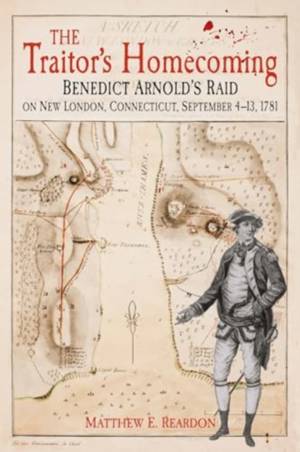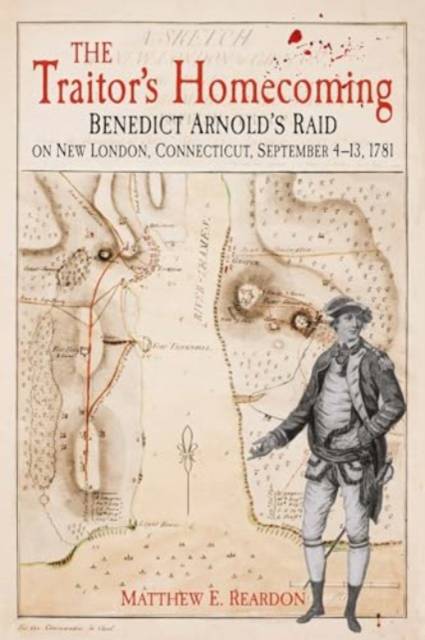
- Afhalen na 1 uur in een winkel met voorraad
- Gratis thuislevering in België vanaf € 30
- Ruim aanbod met 7 miljoen producten
- Afhalen na 1 uur in een winkel met voorraad
- Gratis thuislevering in België vanaf € 30
- Ruim aanbod met 7 miljoen producten
Zoeken
The Traitor's Homecoming
Benedict Arnold's Raid on New London, Connecticut, September 4-13, 1781
Matthew E Reardon
Hardcover | Engels
€ 48,45
+ 96 punten
Omschrijving
A reexamination of Benedict Arnold's 1781 raid on New London, Connecticut, dispelling myths and offering a balanced military study.
Almost everyone is familiar with the name of at least one Revolutionary War battle. Some, like Lexington and Concord, Bunker Hill, Saratoga, and Yorktown are household names. Others are less well known but readily recognized when mentioned. An engagement in Connecticut during the war's seventh year, commanded by one of history's most infamous military names, is not among them. Matthew E. Reardon has set out to rectify that oversight with The Traitor's Homecoming: Benedict Arnold's Raid on New London, Connecticut, September 4-13, 1781.
By 1781, the war in North America had reached a stalemate. That changed during the summer when the combined Franco-American armies of Generals George Washington and Jean-Baptiste comte de Rochambeau deceived British General Sir Henry Clinton into believing they were about to lay siege to New York City. In fact, they were moving south toward Yorktown, Virginia, in a bid to trap Lord Cornwallis's British army against the sea. Clinton fell for the deception and dispatched former American general Benedict Arnold to attack New London. Clinton hoped to destroy the privateers operating out of its harbor and derail militia reinforcements and supplies heading from Connecticut to the allied armies outside New York City.
Situated in southeastern Connecticut, New London was the center of the state's wartime naval activities. State and Continental naval vessels operated out of its harbor, which doubled as a haven for American privateers. Arnold landed on September 6 and, in a textbook operation, defeated local militia, took possession of the town, harbor, and forts, and set New London's waterfront ablaze. But that is not how it is remembered. The Connecticut governor's vicious propaganda campaign against the British and Arnold, who was already infamous for his treachery, created a narrative of partial truths and embellishments that persist to this day. As such, most of the attention remains on the bloody fighting and supposed "massacre" at Fort Griswold. There is much more to the story.
The Traitor's Homecoming uses dozens of newly discovered British and American primary sources to weave a balanced military study of an often forgotten and misunderstood campaign. Indeed, Reardon achieves a major reinterpretation of the battle while dismantling its myths. Thirteen original maps and numerous illustrations and modern photographs flesh out this provocative and groundbreaking study.
Almost everyone is familiar with the name of at least one Revolutionary War battle. Some, like Lexington and Concord, Bunker Hill, Saratoga, and Yorktown are household names. Others are less well known but readily recognized when mentioned. An engagement in Connecticut during the war's seventh year, commanded by one of history's most infamous military names, is not among them. Matthew E. Reardon has set out to rectify that oversight with The Traitor's Homecoming: Benedict Arnold's Raid on New London, Connecticut, September 4-13, 1781.
By 1781, the war in North America had reached a stalemate. That changed during the summer when the combined Franco-American armies of Generals George Washington and Jean-Baptiste comte de Rochambeau deceived British General Sir Henry Clinton into believing they were about to lay siege to New York City. In fact, they were moving south toward Yorktown, Virginia, in a bid to trap Lord Cornwallis's British army against the sea. Clinton fell for the deception and dispatched former American general Benedict Arnold to attack New London. Clinton hoped to destroy the privateers operating out of its harbor and derail militia reinforcements and supplies heading from Connecticut to the allied armies outside New York City.
Situated in southeastern Connecticut, New London was the center of the state's wartime naval activities. State and Continental naval vessels operated out of its harbor, which doubled as a haven for American privateers. Arnold landed on September 6 and, in a textbook operation, defeated local militia, took possession of the town, harbor, and forts, and set New London's waterfront ablaze. But that is not how it is remembered. The Connecticut governor's vicious propaganda campaign against the British and Arnold, who was already infamous for his treachery, created a narrative of partial truths and embellishments that persist to this day. As such, most of the attention remains on the bloody fighting and supposed "massacre" at Fort Griswold. There is much more to the story.
The Traitor's Homecoming uses dozens of newly discovered British and American primary sources to weave a balanced military study of an often forgotten and misunderstood campaign. Indeed, Reardon achieves a major reinterpretation of the battle while dismantling its myths. Thirteen original maps and numerous illustrations and modern photographs flesh out this provocative and groundbreaking study.
Specificaties
Betrokkenen
- Auteur(s):
- Uitgeverij:
Inhoud
- Aantal bladzijden:
- 448
- Taal:
- Engels
Eigenschappen
- Productcode (EAN):
- 9781611216981
- Verschijningsdatum:
- 29/08/2024
- Uitvoering:
- Hardcover
- Formaat:
- Genaaid
- Afmetingen:
- 154 mm x 230 mm
- Gewicht:
- 884 g

Alleen bij Standaard Boekhandel
+ 96 punten op je klantenkaart van Standaard Boekhandel
Beoordelingen
We publiceren alleen reviews die voldoen aan de voorwaarden voor reviews. Bekijk onze voorwaarden voor reviews.











